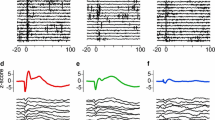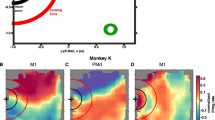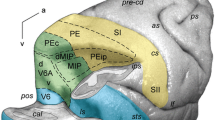Summary
The major goal of this study was to determine whether the activity of single cells in the primate putamen was better related to the direction of limb movement or to the underlying pattern of muscular activity. In addition, the neural responses to load application were studied in order to determine whether the same neurons were also responsive to somatosensory stimuli. Two rhesus monkeys were trained to perform a visuomotor arm tracking task which required elbow flexion/extension movements with assisting and opposing loads in order to dissociate the direction of elbow movement from the pattern of muscular activity required for the movement. Neurons in the putamen were selected for study only if they were related both to the task and to arm movements outside the task. Most (96%) of the cells studied responded to load application: 36% of these showed short-latency(< 50 ms), “sensory” responses. Forty-four percent of neurons had significant relations to the level of static load as the animal held the arm stationary against the steady loads: in general, static load effects were relatively weak. During the elbow flexion/extension movements in the task, 76% of cells had significant relations to the direction of movement, and 52% of neurons had significant dynamic relations to the level of load. Half of all neurons studied were primarily related to the direction of movement independent of the load. Only thirteen percent of cells in the putamen had a pattern of activity similar to that of muscles. These results indicate that neuronal activity in the putamen is predominantly related to the direction of limb movement rather than to the activity of particular muscles and that the basal ganglia may play a role in the specification of parameters of movement independent of the activity of specific muscles. These results also indicate that the basal ganglia receive proprioceptive input which may be used in the control of ongoing movement.
Similar content being viewed by others
References
Albe-Fessard D, Rocha-Miranda C, Oswaldo-Cruz E (1960) Activites evoquees dans le noyou caude du chat en response a des types divers d'afferences. II. Etude microphysiologique. Electroencephal Clin Neurophysiol 12: 649–661
Aldridge JW, Anderson RJ, Murphy JT (1980a) The role of the basal ganglia in controlling a movement initiated by visually presented cue. Brain Res 192: 3–16
Aldridge JW, Anderson RJ, Murphy JT (1980b) Sensory-motor processing in the caudate nucleus and globus pallidus: a single-unit study in behaving primates. Can J Physiol Pharmacol 58: 1192–1201
Anderson ME (1977) Discharge patterns of basal ganglia neurons during active maintenance of postural stability and adjustment to chair tilt. Brain Res 143: 325–338
Anderson ME, Horak FB (1981) Changes in firing of pallidal neurons during arm reaching movements in a reaction time task. Soc Neurosci Abstr 7: 741
Anderson RJ, Aldridge JW, Murphy JT (1976) Somatic and visual feedback to monkey caudate nucleus during a central motor program. Soc Neurosci Abstr 2: 59
Branch MH, Crutcher MD, DeLong MR (1980) Globus pallidus: neuronal responses to arm loading. Soc Neurosci Abstr 6: 272
Cheney PD, Fetz EE (1980) Functional classes of primate corticomotoneuronal cells and their relation to active force. J Neurophysiol 44: 773–791
Conrad B, Wiesendanger M, Matsunami K, Brooks VB (1977) Precentral unit activity related to control of arm movements. Exp Brain Res 29: 85–95
Crutcher MD, DeLong MR (1981) Relation of putamen neuronal discharge to direction of movement or pattern of muscular activity. Soc Neurosci Abstr 7: 778
Crutcher MD, DeLong MR (1982) Functional organization of the primate putamen. Soc Neurosci Abstr 8: 960
Crutcher MD, DeLong MR (1984) Single cell studies of the primate putamen. I. Functional organization. Exp Brain Res 53: 233–243
DeLong MR (1971) Activity of pallidal neurons during movement. J Neurophysiol 34: 414–427
DeLong MR (1972) Activity of basal ganglia neurons during movement. Brain Res 40: 127–135
DeLong MR (1973) Putamen: activity of single units during slow and rapid arm movements. Science 179: 1240–1242
DeLong MR, Georgopoulos AP (1979) Motor functions of the basal ganglia as revealed by studies of single cell activity in the behaving primate. In: Poirier LJ, Sourkes TL, Bedard PJ (eds) Advances in neurology, vol 24. Raven Press, New York, pp 131–140
DeLong MR, Georgopoulos AP (1981) Motor functions of the basal ganglia. In: Brooks VB (ed) Handbook of Physiology. Motor Control. American Physiological Society, Bethesda, pp 1017–1061
Denny-Brown D, Yanagisawa N (1976) The role of the basal ganglia in the initiation of movement. In: Yahr MD (ed) The basal ganglia. Raven Press, New York, pp 115–149
Evarts EV (1967) Representation of movements and muscles by pyramidal tract neurons of the precentral motor cortex. In: Yahr MD, Purpura DP (eds) Neurophysiological basis of normal and abnormal motor activities. Raven Press, New York, pp 215–253
Evarts EV (1968) Relation of pyramidal tract activity to force exerted during voluntary movement. J Neurophysiol 31: 14–27
Evarts EV (1969) Activity of pyramidal tract neurons during postural fixation. J Neurophysiol 32: 375–385
Evarts EV (1973) Motor cortex reflexes associated with learned movement. Science 179: 501–503
Evarts EV, Fromm C (1978) The pyramidal tract neuron as summing point in a closed-loop control system in the monkey. In: Desmeott JE (ed) Cerebral motor control in man: Long loop mechanisms. Karger, Basel, pp 56–69
Evarts EV, Tanji J (1976) Reflex and intended responses in motor cortex pyramidal tract neurons of monkey. J Neurophysiol 39: 1069–1080
Fetz EE, Finocchio DV, Baker MA, Soso MJ (1980) Sensory and motor responses of precentral cortex cells during comparable passive and active joint movements. J Neurophysiol 43: 1070–1089
Georgopoulos AP, Kalaska JF, Caminiti R, Massey JT (1982) On the relations between the direction of two-dimensional arm movements and cell discharge in primate motor cortex. J Neurosci 2: 1527–1537
Georgopoulos AP, DeLong MR, Crutcher MD (1983) Relations between parameters of step-tracking movements and single cell discharge in the globus pallidus and subthalamic nucleus of the behaving monkey. J Neurosci 3: 1586–1598
Hallett M, Khoshbin S (1980) A physiological mechanism of bradykinesia. Brain 103: 301–314
Hepp-Reymond MC, Wyss UR, Anner R (1978) Neuronal coding of static force in the primate motor cortex. J Physiol (Paris) 74: 287–291
Horak FB, Anderson ME (1980) Effects of the globus pallidus on rapid arm movement in monkeys. Soc Neurosci Abstr 6: 465
Hore J, Villis T (1980) Arm movement performance during reversible basal ganglia lesions in the monkey. Exp Brain Res 39: 217–228
Kubota K, Funahashi S (1982) Direction-specific activities of dorsolateral prefrontal and motor cortex pyramidal tract neurons during visual tracking. J Neurophysiol 47: 362–376
Künzle H (1975) Bilateral projections from precentral motor cortex to the putamen and other parts of the basal ganglia. An autoradiographic study in Macaca fascicularis. Brain Res 88: 195–209
Künzle H (1977) Projections from the primary somatosensory cortex to basal ganglia and thalamus in the monkey. Exp Brain Res 30: 481–492
Künzle H (1978) An autoradiographic analysis of the efferent connections from premotor and adjacent prefrental regions (areas 6 and 9) in Macaca fascicularis. Brain Behav Evol 15: 185–234
Lemon RN, Hanby JA, Porter R (1976) Relationship between the activity of precentral neurons during active and passive movements in conscious monkeys. Proc R Soc Lond [B] 194: 341–373
Lemon RN, Porter R (1976) Afferent input to movement-related precentral neurons in conscious monkeys. Proc R Soc Lond [B] 194: 313–339
Liles SL (1974) Single-unit responses of caudate neurons to stimulation of frontal cortex, substantia nigra and entopeduncular nucleus in cats. J Neurophysiol 37: 254–265
Liles SL (1978) Unit activity in the putamen associated with conditioned arm movements: Topographic organization. Fed Proc 37: 396
Liles SL (1979) Topographic organization of neurons related to arm movement in the putamen. In: Chase TN, Wexler NS, Barbeau A (eds) Advances in Neurology, vol. 23. Raven Press, New York, pp 155–162
Liles SL (1981) Activity of neurons in the putamen during movement and postural fixation of the arm against external loads. Soc Neurosci Abstr 7: 778
MacPherson JM, Rasmusson DD, Murphy JT (1980) Activities of neurons in “motor” thalamus during control of limb movement in the primate. J Neurophysiol 44: 11–28
Meyer-Lohmann J, Hore J, Brooks VB (1977) Cerebellar participation in generation of prompt arm movements. J Neurophysiol 40: 1038–1050
Murphy JT, Kwan HC, MacKay WA, Wong YC (1982) Activity of primate precentral neurons during voluntary movements triggered by visual signals. Brain Res 236: 429–449
Neafsey EJ, Hull CD, Buchwald NA (1978) Preparation for movement in the cat. II. Unit activity in the basal ganglia and thalamus. Electroencephal. Clin Neurophysiol 44: 714–723
Rosen I, Asanuma H (1972) Peripheral afferent inputs to the forelimb area of the monkey motor cortex: input-output relations. Exp Brain Res 14: 257–273
Schmidt EM, Jost RG, Davis KK (1975) Reexamination of the force relationship of cortical cell discharge patterns with conditioned wrist movements. Brain Res 83: 213–223
Smith AM, Hepp-Reymond MC, Wyss UR (1975) Relation of activity of precentral cortical neurons to force and rate of force charge during isometric contractions of finger muscles. Exp Brain Res 23: 315–332
Snedecor GW, Cochran WG (1967) Statistical methods, 6th edn. Iowa State University Press, Ames
Snider RS, Lee JC (1961) A stereotaxic atlas of the monkey brain Macaca mulatta. University of Chicago Press, Chicago
Strick PL (1976) Activity of ventrolateral thalamic neurons during arm movement. J Neurophysiol 39: 1032–1044
Strick PL (1978) Cerebellar involvement in “volitional” muscle responses to load changes. In: Desmedt JE (ed) Cerebral motor control in man: Long loop mechanisms. Karger, Basel, pp 85–93
Strick PL (1979) Control of peripheral input to the dentate nucleus by motor preparation. In: Massion J, Sasaki K (eds) Cerebrocerebellar interactions. Elsevier/North-Holland Biomedical Press, Amsterdam, pp 185–201
Thach WT (1978) Correlation of neural discharge with pattern and force of muscular activity, joint position and direction of intended next movement in motor cortex and cerebellum. J Neurophysiol 41: 654–676
Author information
Authors and Affiliations
Additional information
Supported by USPHS grant NS 15417
Rights and permissions
About this article
Cite this article
Crutcher, M.D., DeLong, M.R. Single cell studies of the primate putamen. Exp Brain Res 53, 244–258 (1984). https://doi.org/10.1007/BF00238154
Received:
Issue Date:
DOI: https://doi.org/10.1007/BF00238154




